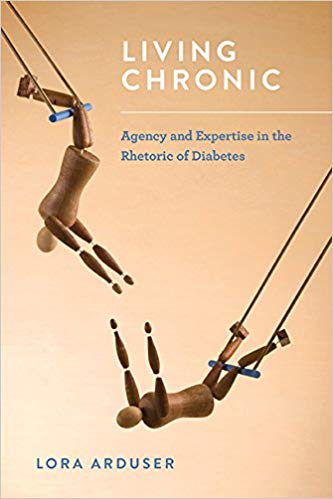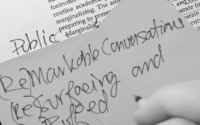Book Review: Arduser’s Living Chronic
Arduser, Lora. Living Chronic: Agency and Expertise in the Rhetoric of Diabetes. Ohio State UP, 2017.
 Americans manage chronic diseases and conditions such as asthma, COPD, arthritis, and, as in Arduser’s book, diabetes, at a truly astounding—and growing—rate. As of 2012, half of all US adults had one or more chronic conditions, and one in four had two or more (Ward et al.). As of 2015, 30.3 million people, or 9.4% of the US population, manage diabetes (ADA). Further, as the American population lives longer, the number of Americans managing diabetes is expected to increase 165% from 2000 to 2050 (Boyle et al.). These statistics have significant impact on both the US healthcare system (it is very expensive to treat chronic conditions over time versus treating acute conditions) and on the people managing chronic illness (it is as difficult to find good care). As more and more Americans go to the doctor to manage chronic conditions, it is crucial to find ways to change medical practice to better facilitate a patient-centered approach that empowers patients to manage these conditions.
Americans manage chronic diseases and conditions such as asthma, COPD, arthritis, and, as in Arduser’s book, diabetes, at a truly astounding—and growing—rate. As of 2012, half of all US adults had one or more chronic conditions, and one in four had two or more (Ward et al.). As of 2015, 30.3 million people, or 9.4% of the US population, manage diabetes (ADA). Further, as the American population lives longer, the number of Americans managing diabetes is expected to increase 165% from 2000 to 2050 (Boyle et al.). These statistics have significant impact on both the US healthcare system (it is very expensive to treat chronic conditions over time versus treating acute conditions) and on the people managing chronic illness (it is as difficult to find good care). As more and more Americans go to the doctor to manage chronic conditions, it is crucial to find ways to change medical practice to better facilitate a patient-centered approach that empowers patients to manage these conditions.
Enter Arduser’s timely book, Living Chronic: Agency and Expertise in the Rhetoric of Diabetes. Arduser meaningfully contributes to this discussion by reimagining the role and identity of the patient in the doctor-patient relationship as it relates to the chronic disease of diabetes. She crafts a new definition of “patient agency” informed by rhetorical theories from the areas of technical communication and medical rhetoric. This interpretative work is supported by her study, a textual analysis of interviews of fourteen people living with diabetes and seven medical professionals, thirty print documents used in group appointments conducted by those professionals, and twenty online diabetes discussion forums.
Arduser uses these interviews to begin the book with the story of what it is like to live with diabetes—specifically, the constant work of self-monitoring blood sugar levels. As Arduser notes, since the 1920s, when insulin was discovered, and especially since the 1970s, medical professionals have advocated a traditional model of compliance with diabetes care, wherein doctors’ orders as to acceptable limits of target blood glucose levels, as well as following other doctors’ orders, should be adhered to in order to be healthy (3-5). In this vein, the doctor’s agency is privileged over patient agency. Arduser argues for a “reconsideration of what qualifies as [patient] agency and expertise in the language and practice of diabetes” (7), as this traditional model of compliance is not in alignment with “professional, social, and cultural shifts” that include the rising number of people with chronic conditions, the changes in healthcare delivery toward more patient-centered models, increased collaboration and communication between doctor and patient, and changes in society “that place a high value on sharing knowledge as well as producing knowledge” (6-7). In her view, then, Arduser believes in “disarticulating agency and compliance” (16).
How might we redefine a notion of agency and expertise for those managing chronic illness that moves from compliance to empowerment? This is the central question of Arduser’s book. Drawing from scholarship in the rhetoric of health and medicine and technical communication, Arduser presents alternative lenses to understand agency, such as agency as authorship (Selzer; Spinuzzi; Winsor) and agency as a form of resistance (Koerber). One of the most impressive features of the text is the consistent paring of rhetorical concepts from these fields with instantiations in diabetes care. She also uses examples from her study, with particular emphasis on excerpts from interviews and online forum discussions, to emphasize what she calls “rearticulations” of patient agency and expertise. She presents these rearticulations in Chapters 2, 3, 4, and 5 and then puts them in conversation in the final chapter to create a new model of agency, discussing its ramifications for several audiences.
Chapter 1 of the book provides the historical background to understand the current landscape of agency and expertise in diabetes. Using interview data, she reveals a narrative of agency largely related to control and, even more specifically, to control through blood glucose numbers. Arduser writes, “People begin to internalize noncompliance as bad behavior, creating a spoiled identity in which they begin to morally judge themselves as bad. High blood sugar numbers reinforce this mentality” (37). Arduser uses examples from websites, films, and interviews to reinforce the notion of person with diabetes as victim, or without willpower, and subject to blame. She also describes how narratives of progress with diabetes technologies and education directly contribute to a notion of the human body as needing to be brought into control, further reducing the agency of the person with diabetes in favor of technologies and texts that might correct it on its own.
Also limiting the agency of the patient is the manner in which space is defined inside of the medical community. In Chapter 2, Arduser describes how the clinical space is largely seen as a binary, with the patient meeting with the doctor or other professionals in a one-on-one encounter, with time conceived of as linear—a single fifteen-minute appointment, a progression of disease, and timing of medication. In Arduser’s view, this time and space reemphasizes medical authority: the patient marches along in a line from person to person and space to space. To refute this notion of space in diabetes care, Arduser presents the concept of liminality to present a more relational definition of agency that “requires locating the person with diabetes inside medicine” (58). She gives examples that blur these traditional boundaries and linear progressions, to include options such as group appointments and online patient communities—spaces in which discussions can take place and are more fluid in terms of expertise and experience. Arduser reinforces this more fluid definition of space in diabetes care with concepts from rhetorical theory such as rhetorical ecologies (Edbauer; Gries) and from technical communication, such as hybrid spaces that merge work and life (McNely; Spinuzzi et al.; Swartz & Kim). Further, Arduser invokes Johndan Johnson-Eilola’s concept of symbolic-analytic worker to describe the work that people with diabetes do in these liminal spaces, such as create videos for online patient community forums and social media platforms. In this way, people with diabetes use writing as a means to enact agency.
A difficulty that Arduser notes with changing the notion of agency in diabetes care inside of the medical community is its privileging of epistemic knowledge over techne. Evidence-based medicine dictates that a medical professional should only practice what the the scientific literature verifies through systematic and reproducible studies. But people with diabetes are also seeking to learn how to manage their conditions given their unique lived experiences. In essence, they seek techne and the bodily knowledge of themselves and other people with diabetes to navigate their care of diabetes. Here, Arduser draws on Sauer’s notion of “pit sense” or “an embodied sensory knowledge derived from site-specific practice in a particular working environment” (219). One of Arduser’s interviewees calls this “finding what works for you” (88). For this reason, in Chapter 3 she theorizes this work as rhetorical plasticity or “performing agency through articulating and rearticulating epistemic, practical, and bodily knowledge” (99-100). People with diabetes are doing this work in collaboration with one another and in collaboration with medical professionals, and Arduser likens this work to that of makers in makerspaces.
In Chapter 4, Arduser discusses how people with diabetes inhabit shifting subjectivities wherein in one moment they may be an expert and in another a novice—and that these shift depending on the space and encounter. She uses examples from online discussion forums to show how people discuss their situations with diabetes, revealing subject matter expertise as to tests and procedures that they conduct at home (101). People with diabetes mentor one another in group education spaces and identify with one another (Arduser references Burkean identification here) when they share similar lived experiences. Also referred to as interactional expertise, Arduser observed this in group education sessions and online, yet the immersive and relational experiences that these spaces generate are still lacking in traditional doctor-patient interactions and in medical literature about diabetes. For this reason, patient agency is still limited in more institutional locations.
Arduser next presents another rearticulation of patient agency: that, through mimesis, or speaking or acting in the vein of a medical professional, people with diabetes can enact professional identities “but still retain the ability to shift back to the discourse of lived experience and the expert patient” (125). In Chapter 5, she discusses three specific examples. First, people with diabetes often perform reported speech or re-quoting their medical professionals in such a way as to assert authority over them. Second, expert patients often align themselves with professionals, answering questions and mentoring others with less experience managing diabetes. Finally, some people with diabetes mimic scientific research practices, conducting research and using experimentation as “a method of discovery” when acting as participants in clinical trials. In all of these examples, people with diabetes are performing agency by inserting themselves within the medical community, attempting to make room where more established medical authority would normally shut them out.
In her concluding chapter, Arduser offers two questions to serve as a heuristic for “creating rhetorically grounded understandings of health and disease that will facilitate our understandings of the cultural forms of other chronic diseases” (151). These are as follows:
- What articulations are currently enacted?
- What alternate articulations are possible?
She then juxtaposes the linear, top-down model of agency as it is currently understood to an alternative model for agency that combines the concepts discussed in the earlier chapters—liminality, plasticity, subjectivities, and identities. While I appreciated the figure presented that puts these concepts into concentric circles, I felt this model in its entirety might have been presented earlier, along with more discussion of how these rearticulations of agency might fit together. Without front-loading the model, the reader is left until the end to speculate what holds together these concepts and chapters. An earlier introduction to the model may allow readers better wayfinding through the book.
The implication of this model, she argues, is great for patient-centered practices such as shared decision-making, a cornerstone of the innovations necessary and recommended for improved service delivery and health outcomes for those managing chronic conditions. Arduser includes in shared decision-making the creation of more patient-centered education and patient-centered texts, two areas in which scholar-teachers in rhetoric and composition studies and technical communication have much to offer.
Arduser’s conclusion is also a beginning. She shows us how her reimagined rhetoric of agency opens a pathway to more work to improve communication in the healthcare system, particularly targeting “deep language changes” in medicine rather than merely word substitution (166). As the book evidences, the difficulties in making change in the healthcare system are many; however, Arduser’s rhetorical work here that bridges patient agency with patient empowerment and shared decision-making aligns well with the recommendations of policy analysts as well as US government agencies such as the Agency for Healthcare Research and Quality. The greatest benefit of Arduser’s book is to show how rhetoricians might participate in the change needed to align the delivery of health care in this country with these principles.
Works Cited
- American Diabetes Association (ADA). “Statistics about Diabetes.” diabetes.org, www.diabetes.org/diabetes-basics/statistics. Accessed 1 May 2018.
- Boyle, James P., Amanda A. Honeycutt, K. M. Venkat Narayan, Thomas J. Hoerger, Linda S. Geiss, Hong Chen, and Theodore J. Thompson. “Projection of Diabetes Burden through 2050.” Diabetes Care, vol. 24, no. 11, 2001, pp. 1936-40.
- Edbauer, Jenny. “Unframing Models of Public Distribution: From Rhetorical Situation to Rhetorical Ecologies.” Rhetoric Society Quarterly, vol. 35, no. 4, 2005, pp. 5-24.
- Gries, Laurie. “Agential Matters: Tumbleweed, Women-Pens, Citizen-Hope, and Rhetorical Actancy.” Ecology, Writing Theory, and New Media, edited by Sidney J. Dobrin, Routledge, 2015, pp. 67-91.
- Johnson-Eilola, Johndon. “Relocating the Value of Work: Technical Communication in a Post-Industrial Age.” Technical Communication Quarterly, vol. 5, no. 3, 1996, pp. 245-70.
- Koerber, Amy. “Rhetorical Agency, Resistance, and the Disciplinary Rhetorics of Breastfeeding.” Technical Communication Quarterly, vol. 15, no. 1, 2006, pp. 87-101.
- McNely, Brian. “Knowledge Work, Knowledge Play: A Heuristic Approach to Communication Design for Hybrid Spaces.” Communication Design Quarterly, vol. 2, no. 4, 2014, pp. 14-51.
- Selzer, Jack. “Rhetorical Analysis: Understanding How Texts Persuade Readers.” What Writing Does and How It Does It: An Introduction to Analyzing Texts and Textual Practices, edited by Charles Bazerman and Paul Prior, Lawrence Erlbaum, 2004, pp. 279-307.
- Spinuzzi, Clay, William Hart-Davidson, and Mark Zachry. “Chains and Ecologies: Methodological Notes Toward a Communicative-Meditational Model of Technologically-Mediated Writing.” Proceedings of the 24thAnnual ACM International Conference on Design of Communication, 2006, pp. 43-50.
- Swarts, Jason, and Loel Kim. “Guest Editors’ Introduction: New Technological Spaces.” Technical Communication Quarterly, vol. 18, no. 3, 2009, pp. 211-23.
- Ward, Brian W., Jeannine S. Schiller, and Richard A. Goodman. “Multiple Chronic Conditions among US Adults: A 2012 Update.” Preventing Chronic Disease, vol. 11, 2014, pp. E62.
- Winsor, Dorothy A. “Using Writing to Structure Agency: An Examination of Engineers’ Practice.” Technical Communication Quarterly, vol. 15, no. 4, 2006, pp. 411-30.
Keywords: rhetoric of health and medicine, chronic care, diabetes, agency, expertise




 Dawn S. Opel is Assistant Professor of Digital Media and User Experience in the Department of Writing, Rhetoric, and American Cultures at Michigan State University. A community-engaged action researcher, she works with legal, social services, and healthcare professionals to improve the design of communication for coordination of patient care. Dawn teaches courses in medical and digital rhetorics, community literacy studies, and user experience. Her recent published work appears in Computers and Composition and Technical Communication.
Dawn S. Opel is Assistant Professor of Digital Media and User Experience in the Department of Writing, Rhetoric, and American Cultures at Michigan State University. A community-engaged action researcher, she works with legal, social services, and healthcare professionals to improve the design of communication for coordination of patient care. Dawn teaches courses in medical and digital rhetorics, community literacy studies, and user experience. Her recent published work appears in Computers and Composition and Technical Communication.